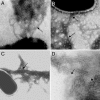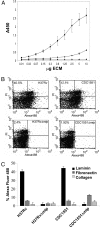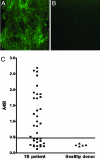Mycobacterium tuberculosis produces pili during human infection
- PMID: 17360408
- PMCID: PMC1817835
- DOI: 10.1073/pnas.0602304104
Mycobacterium tuberculosis produces pili during human infection
Abstract
Mycobacterium tuberculosis is responsible for nearly 3 million human deaths worldwide every year. Understanding the mechanisms and bacterial factors responsible for the ability of M. tuberculosis to cause disease in humans is critical for the development of improved treatment strategies. Many bacterial pathogens use pili as adherence factors to colonize the host. We discovered that M. tuberculosis produces fine (2- to 3-nm-wide), aggregative, flexible pili that are recognized by IgG antibodies contained in sera obtained from patients with active tuberculosis, indicating that the bacilli produce pili or pili-associated antigen during human infection. Purified M. tuberculosis pili (MTP) are composed of low-molecular-weight protein subunits encoded by the predicted M. tuberculosis H37Rv ORF, designated Rv3312A. MTP bind to the extracellular matrix protein laminin in vitro, suggesting that MTP possess adhesive properties. Isogenic mtp mutants lost the ability to produce Mtp in vitro and demonstrated decreased laminin-binding capabilities. MTP shares morphological, biochemical, and functional properties attributed to bacterial pili, especially with curli amyloid fibers. Thus, we propose that MTP are previously unidentified host-colonization factors of M. tuberculosis.
Conflict of interest statement
The authors declare no conflict of interest.
Figures




References
-
- Dye C, Scheele S, Dolin P, Pathania V, Raviglione MC. J Am Med Assoc. 1999;282:677–686. - PubMed
-
- Frieden TR, Sterling TR, Munsiff SS, Watt CJ, Dye C. Lancet. 2003;362:887–899. - PubMed
-
- Shepard CC. Proc Soc Exp Biol Med. 1955;90:392–396. - PubMed
-
- Schlesinger LS, Bellinger-Kawahara CG, Payne NR, Horwitz MA. J Immunol. 1990;144:2771–2780. - PubMed
Publication types
MeSH terms
Substances
Grants and funding
LinkOut - more resources
Full Text Sources
Other Literature Sources
Medical
Molecular Biology Databases

